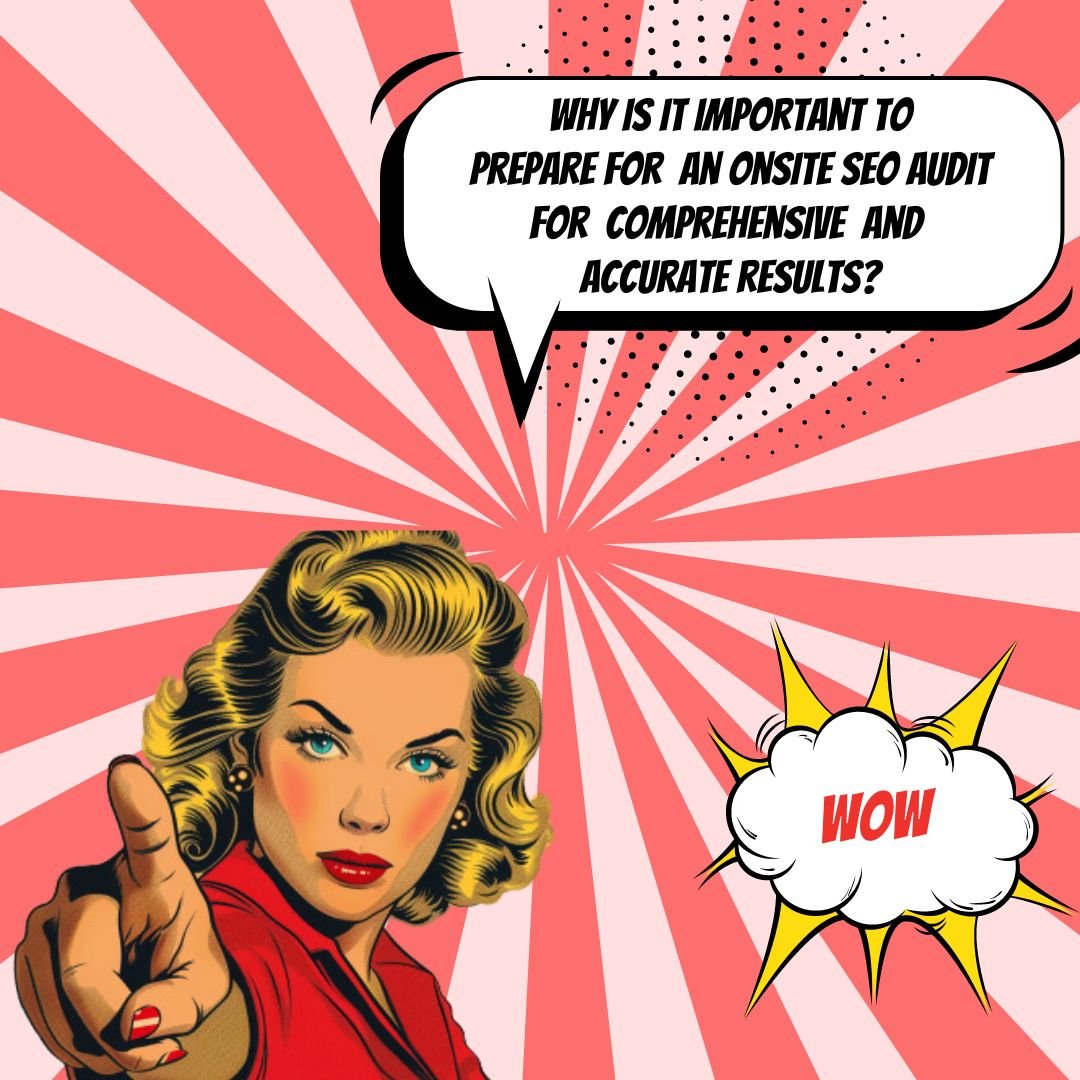Key Takeaways
✅ Define Goals and Scope: Setting clear benchmarks for what an onsite SEO audit should accomplish is the first stride towards digital supremacy. Whether it's upping visitor traffic or climbing the ranks in search results, it's vital to pinpoint where you want to go and what areas of your website need attention. It's not just about aimlessly roaming through data – bringing along robust analytical tools and charting measurable goals, like traffic growth or keyword prominence, can pave a clear path to improvement.
✅ Gather Essential Tools and Data: The truth is, you can't fix what you don't know is broken. Having the right gear in your digital toolkit – think Google Search Console, Google Analytics, and crawl software like Screaming Frog – is like having the right wrench for a stubborn bolt. Pulling together data that outlines how your site's current performance stacks up against the competition, scrutinizing bounce rates, or tracking how visitors engage with your content isn't just number-crunching; it’s laying the groundwork for a game-changing strategy.
✅ Conduct a Comprehensive Website Crawl: To truly grasp the health of your website, sending out a digital probe across every page is a must. With tools such as SEMrush or Screaming Frog, these deep-dives can unearth a range of glitches, from pesky broken links and overlooked duplicate content to misfiring meta tags and pages that take an age to load. It's about more than just making sure things work; it's about ensuring that the experience you're offering is as polished and professional as your business aims to be.

Introduction
Ever felt like your website is the needle in the online haystack? Want to shine online and attract more customers, but not sure how to start? Preparing for an onsite SEO audit is your golden ticket to transforming your online space into a beacon for visitors and search engines alike.
Imagine cutting through the clutter and ranking boldly where your audience can't miss you. That's the power of a well-executed SEO audit. It's not just about understanding algorithms or inserting keywords; it’s about crafting an online experience that's both user-friendly and Google-friendly.
With our article, you'll dive headfirst into modern SEO strategies and innovative practices, all simplified and laid out in plain sight. Think of it as a road map to that coveted top-spot in search rankings, a treasure trove of knowledge aimed at maximizing your return on investment.
Embrace actionable insights and ground-breaking information tailored for your SEO journey. Roll up your sleeves, and let’s get digital – success is just a click away!

Top Statistics
| Statistic | Insight |
|---|---|
| 68% of online experiences begin with a search engine. | This shows the tremendous impact that search engines have on user behavior and why an optimized presence is crucial for businesses. |
| 95% of pages have zero backlinks. | Highlighting the scarcity of backlinks for most pages emphasizes the opportunity for competitive advantage through strategic link-building. |
| The #1 result is 10x more likely to get a click compared to the 10th. | This statistic underscores the immense value of ranking at the top and the need to be meticulous during your SEO audit. |
| SEO drives 1,000%+ more traffic than organic social media. | Companies often invest heavily in social media, but this shows that a well-optimized website can lead to significantly higher traffic gains. |
| Google makes up for 93.87% of the mobile search engine market. | This dominance reinforces why optimizing for Google's search algorithms can be a game-changer for your mobile audience reach. |
Understanding the Importance of an Onsite SEO Audit
When you take a step back to evaluate your website's performance, an onsite SEO audit stands out as an indispensable tool. Think of this audit as a thorough check-up for your online presence. It zeroes in on how visible your website is to search engines and potential customers. With proper auditing, you're not just crossing fingers and hoping for the best; you're employing a strategic method to climb the search engine rankings. This process involves detailed analysis, from examining your website's structure to ensuring that each page leads to a friendly handshake with search engines.

Setting Clear Objectives
Before diving into the numbers and charts, it's crucial to determine what you want to achieve with your SEO audit Setting out with clear, measurable, achievable, relevant, and time-bound (SMART) goals can provide direction and focus for the audit, shaping the way you view your website's performance. Is your site slowing to a crawl? Are the right people finding their way to your content? Establishing a baseline for these key performance indicators is the first step towards measurable improvement.
Gathering Essential Tools and Resources
The digital toolbox for a comprehensive SEO audit includes heavy hitters like Google Analytics but also other specialist software such as SEMrush or Screaming Frog SEO Spider. Each is designed to dissect various parts of your website's performance from different angles. For instance, Google Analytics offers insights into visitor behavior, whereas SEMrush can help pinpoint keyword opportunities. Choosing which tools to utilize will depend on your specific needs and the size of your wallet, but investing wisely here can save invaluable time and resources down the line.
Preparing Your Website for the Audit
The readiness of your website can make or break your audit. Ensuring search engines can crawl and understand your site is groundwork not to be skipped. Is your navigation easy to follow? Is the site structure logical and conducive to a good user experience? Don't let technical hiccups like broken links or sneaky issues like duplicate content derail your SEO efforts. Sweeping the path clean for the audit involves rolling up the sleeves and ironing out these kinks beforehand.
Conducting a Pre-Audit Review
A comprehensive pre-audit review involves a close-up examination of your website's on-page elements. This includes the optimization of meta tags and scrutinizing whether your heading hierarchies make sense to both the user and search engines. In this stage, it's crucial to assess your content's quality and relevance—because at the end of the day, content is king. Additionally, as the world goes mobile and user patience dwindles, ensuring your website loads quickly and smoothly on all devices is no longer optional.

Best Practices for a Successful Audit
Embarking on an SEO audit can unearth a laundry list of issues. Prioritizing these findings is key—tackle the changes that will have the most significant impact first. A robust action plan, along with strategies to monitor the progress, will help you stay on course. Remember, SEO isn't a one-off; it requires ongoing maintenance. The digital landscape is ever-evolving, and regular check-ups are essential to maintain and improve your website's health and ranking.
AI Marketing Engineers Recommendation
Recommendation 1: Establish Clear Goals and Benchmark Current Performance: Before diving into an onsite SEO audit, it is crucial to understand what you want to achieve. Are you aiming for increased traffic, higher rankings for specific keywords, or improved user engagement? Once your goals are set, benchmark your website's current SEO performance to measure progress post-audit accurately. For instance, according to BrightEdge, "68.5% of clicks go to the top five organic search results," highlighting the importance of ranking high. Use tools like Google Analytics to track current website traffic, conversion rates, and keyword rankings as your baseline.
Recommendation 2: Prioritize Mobile Optimization in Your Audit Planning: With Statista reporting that 58.99% of global website traffic comes from mobile devices as of the second quarter of 2022, ensuring your website is mobile-friendly is no longer optional. In preparing for your audit, prioritize assessing the mobile user experience, site speed, and responsive design. Google’s mobile-first indexing means the search engine predominantly uses the mobile version of the content for indexing and ranking, which could significantly impact your site’s visibility if not optimized properly.
Recommendation 3: Leverage Comprehensive SEO Audit Tools to Uncover Technical Issues: Tools like SEMrush, Ahrefs, or Google Search Console can provide in-depth insights into technical aspects of your website that may be hindering SEO performance. Use these tools for a thorough onsite SEO audit to identify issues like broken links, crawl errors, or slow-loading pages. SEMrush, for example, offers an on-page SEO checker that can give you actionable recommendations for improvement. Addressing these issues promptly can lead to a smoother website experience for visitors and better rankings on search engines.

Relevant Links
- E-commerce Essentials: Tactics for Boosting Online Presence & Sales
- Revolutionize Your ROI: Performance Marketing Power Strategies in India
- Dominate the German Search Scene: Advanced SEO Mastery
- Conquering the Chinese Market: Innovative Digital Marketing Strategies
- Navigate China's E-commerce Titans: Strategic Mastery for Tmall & JD.com
Conclusion
Preparing for an onsite SEO audit is a critical step toward strengthening the digital footprint of your business. By understanding the significance of an onsite audit, you can uncover a multitude of opportunities to enhance your website's visibility and search engine rankings. The benefits are clear: a well-executed audit can give you a competitive edge, helping you to attract more visitors and convert them into customers.
Setting clear objectives is the foundation of a successful SEO audit. It is important to identify what you want to achieve—be it faster site speed, improved user experience, or better keyword rankings. Like any good plan, determining what success looks like upfront will guide your efforts and make your outcomes more measurable.
Don't underestimate the importance of gathering the right tools and resources. With the plethora of SEO tools available, choosing the ones that align with your goals and budget is imperative. Can you imagine a builder without a hammer or a chef without a knife? The same goes for SEO; the right tools can make or break your audit.
When preparing your website for the audit, remember that attention to detail can lead to significant improvements in site performance. From ensuring crawlability to reviewing site structure, each step you take to iron out technical kinks can lead to better rankings.
And let's not forget the pre-audit review. This thorough examination of your on-page elements and content quality sets the stage for actionable insights. It's like looking under the hood of a car before a race; you want to make sure everything is in top condition.
Lastly, best practices should be the thread that ties all your audit activities together. Prioritizing issues, creating an action plan, and implementing changes are steps that demand meticulous attention. Regular audits and ongoing maintenance are not just recommended; they are essential for staying ahead in the ever-changing landscape of SEO.
So, have you scheduled your next onsite SEO audit yet? Remember, an ounce of prevention is worth a pound of cure, especially when it comes to your business's online presence.

FAQs
Question 1: What is the primary objective of an SEO audit?
Answer: The main goal here is pretty straightforward: we want to figure out how we can make your website better so that it can climb those search engine ranks, attract more visitors, and really get those conversion numbers ticking up.
Question 2: What are the key components of an SEO audit?
Answer: Think of an SEO audit as a health check-up for your website. It's going to cover the nuts and bolts (that's your technical SEO), what your website looks like and how it reads (on-page SEO), what's the buzz about your website in the digital world (off-page SEO), and how your content is connecting with your audience.
Question 3: Why is it important to prepare for an SEO audit?
Answer: It's like studying for an exam – the better you prepare, the better your results will be. Preparation helps your SEO expert understand what makes your business tick, what you've tried before, and what you're hoping to achieve.
Question 4: What technical SEO elements should I review before the audit?
Answer: We're talking about making sure your website can be found and understood by search engines without any hiccups. Check how fast it loads, how easy it is for search engine bots to crawl, and if your site plays nice with mobile devices.
Question 5: How do I optimize my website's content for SEO?
Answer: Content is king, as they say. So, you should focus on creating stuff that people will love to read and share, but also make sure you're hitting those sweet, sweet keywords that help search engines understand that your content is relevant.
Question 6: What role does keyword research play in an SEO audit?
Answer: Keyword research is like the compass for your SEO strategy. It guides you to discover what words and phrases your potential customers are punching into those search bars so you can tailor your content to meet their needs.
Question 7: What information should I provide to the auditor?
Answer: Hand over the keys to your digital kingdom – think access to analytics, search console, and any history of previous SEO work. The more the auditor knows, the better the advice you'll receive.
Question 8: How can I ensure effective communication with the auditor?
Answer: Clear communication is crucial. Make sure there's a dedicated person for your SEO guru to talk to, establish what you expect from each other, and never hesitate to ask if something doesn't make sense.
Question 9: What are the best practices for implementing audit recommendations?
Answer: Strategy is everything. You've got to weigh out which recommendations will make the biggest splash and which ones you can realistically tackle. Once you start, keep an eye on those metrics to see how things are improving.
Question 10: How do I measure the success of an SEO audit?
Answer: It's all in the numbers – track your traffic, see where you're ranking, gauge how many people are clicking through, and most importantly, monitor whether all this effort is translating into actual business results.

Academic References
- Soomro, M. (2023). On-Page SEO Audits: A Step-by-Step Guide to Website Optimization. LinkedIn. This resource outlines the critical steps for optimizing specific on-page elements, including title tags, URL structure, and the quality of content, which are fundamental in preparing for an onsite SEO audit.
- New Path Digital. SEO Website Audit | A Comprehensive Guide with Checklist. New Path Digital. This guide provides a comprehensive checklist for conducting a thorough SEO audit, highlighting the importance of technical SEO, content analysis, and user experience.
- OnCrawl. (2016). How to run an Onsite SEO audit using OnCrawl? OnCrawl. This article presents techniques for conducting an effective onsite SEO audit with a focus on indexing, crawling, and other technical SEO aspects, essential for understanding how search engines interact with a site.
- Semrush. (2022). How to Perform a Complete SEO Audit (in 14 Steps). Semrush. Semrush's guide breaks down the SEO audit process into actionable steps, providing an in-depth approach to analyzing a website's technical health, traffic, and backlinks.
- Backlinko. (2024). The 15-Step SEO Audit Checklist for 2024. Backlinko. This forward-looking checklist anticipates the essential components of an SEO audit for the near future, addressing the latest tactics and strategies for optimizing a website's performance in search engine rankings.





